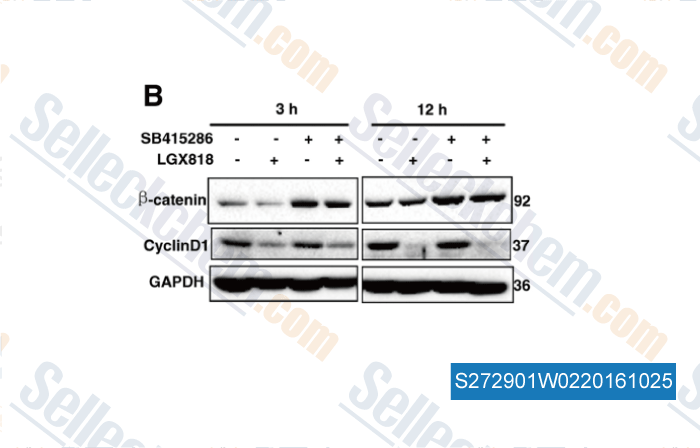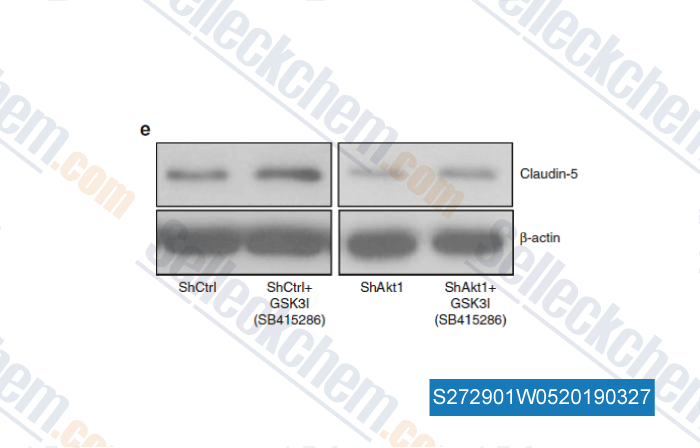|
Toll Free: (877) 796-6397 -- USA and Canada only -- |
Fax: +1-832-582-8590 Orders: +1-832-582-8158 |
Tech Support: +1-832-582-8158 Ext:3 Please provide your Order Number in the email. |
Technical Data
| Formula | C16H10ClN3O5 |
||||||
| Molecular Weight | 359.72 | CAS No. | 264218-23-7 | ||||
| Solubility (25°C)* | In vitro | DMSO | 72 mg/mL (200.15 mM) | ||||
| Ethanol | 72 mg/mL (200.15 mM) | ||||||
| Water | Insoluble | ||||||
| In vivo (Add solvents to the product individually and in order) |
|
||||||
|
* <1 mg/ml means slightly soluble or insoluble. * Please note that Selleck tests the solubility of all compounds in-house, and the actual solubility may differ slightly from published values. This is normal and is due to slight batch-to-batch variations. * Room temperature shipping (Stability testing shows this product can be shipped without any cooling measures.) |
|||||||
Preparing Stock Solutions
Biological Activity
| Description | SB415286 is a potent GSK3α inhibitor with IC50/Ki of 78 nM/31 nM with equally effective inhibition of GSK-3β. SB415286 causes MM cell growth arrest and apoptosis. | ||||
|---|---|---|---|---|---|
| Targets |
|
||||
| In vitro | SB 415286 inhibits GSK3α in an ATP competitive manner with Ki of 31 nM and shows similar potency against GSK3β. SB 415286 has little or no activity against 24 other protein kinases with IC50 > 10 μ M. SB 415286 stimulates glycogen synthesis in the Chang human liver cell line with EC50 of 2.9 μM, and induces expression of a β-catenin-LEF/TCF regulated reporter gene in HEK293 cells. [1] SB 415286 protects both central and peripheral nervous system neurones in culture from death induced by reduced PI3-kinase pathway activity in a concentration-dependent manner, which is correlated with inhibition of GSK-3 activity and modulation of GSK-3 substrates tau and β-catenin. [2] In L6 myotubes, SB 415286 induces a much greater activation of GS (6.8-fold) compared to that elicited by insulin (4.2-fold) or Li (4-fold). [3] SB 415286 (10 μM) inhibits rapamycin-induced down-regulation of cyclin D1, and blocks rapamycin and -induced apoptosis, suggesting a critical role for GSK3β in rapamycin-mediated -sensitization. [4] SB 415286 prevents coxsackievirus-induced cell death in a dose-dependent manner via stabilization of β-catenin. [5] SB 415286 exerts a protective effect on hydrogen peroxide-induced cell death in B65 rat neuroblastoma cells and neurons, while lithium does not attenuate the toxic effects of hydrogen peroxide. [7] SB 415286 treatment potentiates TRAIL- and CH-11-induced apoptosis in HepG2 cells. [8] Inhibition of GSK-3 by SB 415286 causes multiple myeloma (MM) cell growth arrest and apoptosis through the activation of the intrinsic pathway. [9] SB 415286 decreases the viability of Neuro-2A cells, and induces the accumulation of cells in the G2/M phase of the cell cycle and subsequent apoptosis. [10] |
||||
| In vivo | Administration of SB 415286 (~10 mg/kg twice daily) reduces the extent and degree of the trinitrobenzene sulphonic acid (TNBS)-provoked colonic inflammation in the rat, and reduces the fall in body weight, which is related to downregulation of NF-κB activity, involved in the generation of proinflammatory mediators. [6] SB 415286 treatment at 1 mg/kg significantly delays the growth of Neuro-2A cells in vivo in nude mice. [10] |
Protocol (from reference)
| Kinase Assay: |
|
|---|---|
| Cell Assay: |
|
| Animal Study: |
|
References
Customer Product Validation

-
, , Cancer Lett, 2016, 370(2):332-44.

-
Data from [Data independently produced by , , Br J Cancer, 2018, 118(11):1464-1475]

-
Data from [Data independently produced by , , Oncotarget, 2016, 7(41):67071-67086]

-
Data from [Data independently produced by , , Oncotarget, 2016, 7(13):16023-37]
Selleck's SB415286 has been cited by 22 publications
| GSK-3 regulates CD4-CD8 cooperation needed to generate super-armed CD8+ cytolytic T cells against tumors [ bioRxiv, 2025, 2025.03.08.642085] | PubMed: 40161618 |
| Sec-O-Glucosylhamaudol Inhibits RANKL-Induced Osteoclastogenesis by Repressing 5-LO and AKT/GSK3β Signaling [ Front Immunol, 2022, 13:880988] | PubMed: 35558084 |
| Establishment and characterization of immortalized sweat gland myoepithelial cells [ Sci Rep, 2022, 12(1):7] | PubMed: 34997030 |
| Loss of GSK-3β mediated phosphorylation in HtrA2 contributes to uncontrolled cell death with Parkinsonian phenotype [ Int J Biol Macromol, 2021, 180:97-111] | PubMed: 33716130 |
| Regulation of CRMP2 by Cdk5 and GSK-3β participates in sevoflurane-induced dendritic development abnormalities and cognitive dysfunction in developing rats [ Toxicol Lett, 2021, 341:68-79] | PubMed: 33548343 |
| Three paralogous clusters of the miR-17~92 family of microRNAs restrain IL-12-mediated immune defense. [ Cell Mol Immunol, 2020, 10.1038/s41423-020-0363-5] | PubMed: 32015501 |
| Actionable Cytopathogenic Host Responses of Human Alveolar Type 2 Cells to SARS-CoV-2 [ Mol Cell, 2020, 80(6):1104-1122.e9] | PubMed: 33259812 |
| Small Molecule Inhibitors of DYRK1A Identified by Computational and Experimental Approaches [ Int J Mol Sci, 2020, 21(18)E6826] | PubMed: 32957634 |
| A novel human colon signet-ring cell carcinoma organoid line: establishment, characterization and application [ Carcinogenesis, 2020, 41(7):993-1004] | PubMed: 31740922 |
| Lithium and GADL1 regulate glycogen synthase kinase-3 activity to modulateKCTD12expression [ Scientific Reports, 2019, 10255-2019)] | PubMed: None |
RETURN POLICY
Selleck Chemical’s Unconditional Return Policy ensures a smooth online shopping experience for our customers. If you are in any way unsatisfied with your purchase, you may return any item(s) within 7 days of receiving it. In the event of product quality issues, either protocol related or product related problems, you may return any item(s) within 365 days from the original purchase date. Please follow the instructions below when returning products.
SHIPPING AND STORAGE
Selleck products are transported at room temperature. If you receive the product at room temperature, please rest assured, the Selleck Quality Inspection Department has conducted experiments to verify that the normal temperature placement of one month will not affect the biological activity of powder products. After collecting, please store the product according to the requirements described in the datasheet. Most Selleck products are stable under the recommended conditions.
NOT FOR HUMAN, VETERINARY DIAGNOSTIC OR THERAPEUTIC USE.
